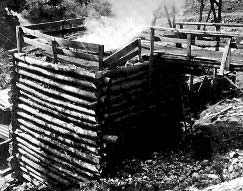

 Following the Civil War, increased growth of the State led to the development
of quarries for building stone and lime. The Shenandoah Valley in Jefferson
and Berkeley counties has extensive limestone and dolomite deposits, and
early on the valley became the center of limestone production in the State.
By about 1900, numerous large quarries were opened for the manufacture of lime,
railroad ballast, and flux for the iron and steel industries. The limestone
was also used for cement, particularly Portland cement, which requires a
high-grade limestone with definite proportions of silica, alumina, and lime.
Farther west, the value of the Greenbrier Limestone was soon realized as a
source for Portland cement. It was also used for building stone, lime, and
furnace flux as early as 1885, though the industry was not as large as to the
east. There has been increasing demand in more recent years for very
high-quality limestone to be used as rock dust in deep mines, and parts of the
Greenbrier Limestone are well-suited for this purpose. Numerous small quarries
also have been developed in the freshwater limestones of central West Virginia;
the limestone is used as construction aggregate, often for highways and
their maintenance.
Today, limestone production in West Virginia exceeds 10 million tons per year.
The large quarries in Berkeley and Jefferson counties account for almost half
of this. Greer Limestone Company, in Monongalia County, also produces a large
amount. The best quality limestone is used as rock dust and for chemical
purposes in manufacturing. Other uses today are for metallurgical flux,
cement, agricultural lime, and construction aggregate and ballast. In the
future, limestone may play an important role in coal conversion plants and as
a precipitant in scrubbing stack gases from coal furnaces. The State is
well endowed with an adequate quality and quantity of limestones to meet any
future needs.
Following the Civil War, increased growth of the State led to the development
of quarries for building stone and lime. The Shenandoah Valley in Jefferson
and Berkeley counties has extensive limestone and dolomite deposits, and
early on the valley became the center of limestone production in the State.
By about 1900, numerous large quarries were opened for the manufacture of lime,
railroad ballast, and flux for the iron and steel industries. The limestone
was also used for cement, particularly Portland cement, which requires a
high-grade limestone with definite proportions of silica, alumina, and lime.
Farther west, the value of the Greenbrier Limestone was soon realized as a
source for Portland cement. It was also used for building stone, lime, and
furnace flux as early as 1885, though the industry was not as large as to the
east. There has been increasing demand in more recent years for very
high-quality limestone to be used as rock dust in deep mines, and parts of the
Greenbrier Limestone are well-suited for this purpose. Numerous small quarries
also have been developed in the freshwater limestones of central West Virginia;
the limestone is used as construction aggregate, often for highways and
their maintenance.
Today, limestone production in West Virginia exceeds 10 million tons per year.
The large quarries in Berkeley and Jefferson counties account for almost half
of this. Greer Limestone Company, in Monongalia County, also produces a large
amount. The best quality limestone is used as rock dust and for chemical
purposes in manufacturing. Other uses today are for metallurgical flux,
cement, agricultural lime, and construction aggregate and ballast. In the
future, limestone may play an important role in coal conversion plants and as
a precipitant in scrubbing stack gases from coal furnaces. The State is
well endowed with an adequate quality and quantity of limestones to meet any
future needs.

Please send questions, comments, and/or suggestions to webmaster.
Page created and maintained by:
West Virginia Geological and Economic Survey
Address: Mont Chateau Research Center
1 Mont Chateau Road
Morgantown, WV 26508-8079
Telephone: 304-594-2331
FAX: 304-594-2575
Hours: 8:00 a.m. - 5:00 p.m. EST, Monday - Friday
Permission to reproduce this material is granted if acknowledgment is given to the West Virginia Geological and Economic Survey.